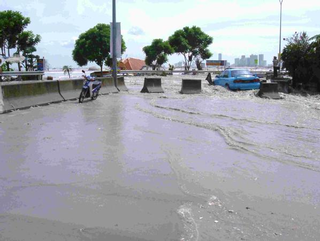This article needs to be updated. (November 2010) |

Malaysia was affected by the 2004 Indian Ocean earthquake and tsunami on 26 December 2004. Despite its proximity to the epicentre of the earthquake, Malaysia escaped the kind of damage that struck countries hundreds of miles further away. Since the epicentre was on the western coast of Sumatra, the island largely protected the country from the worst of the tsunami. The country's worst affected areas were the northern coastal areas and outlying islands like Penang and Langkawi. The simple red flag warning system used by lifeguards on beaches in some resort areas in Penang was credited to reducing the number of fatalities.
The number of deaths currently stands at 67 with 52 in Penang, 12 in Kedah, 2 in Perak and 1 in Selangor.[1] The deaths at Penang were reported to include many picnickers and children who were playing on open public beaches. No deaths were reported among foreign tourists. Houses in fishing villages along coastal areas were damaged in Batu Ferringhi and Balik Pulau in Penang. Coastal areas in Peninsular Malaysia e.g. 13 villages in Kuala Muda, Kedah and Kuala Triang in Langkawi island were also affected. About a quarter of holiday vessels anchored in Rebak and Telaga harbour in Langkawi were also damaged. The waves sent parked motorcycles crashing and cars washed with mud at stretches along Gurney Drive in George Town, Penang. The biggest loss from a single family was when five of Zulkifli Mohamad Noor's seven children were killed when the tsunami struck at Pasir Panjang beach. Sinkholes which were reported in Kampar and Ipoh for three days running have been investigated and determined not to be earthquake related. It was disaster for the people there on that day.
- ^ "2004 Indian Ocean Tsunami in Malaysia". encyclopedia.pub. Retrieved 2 March 2023.
